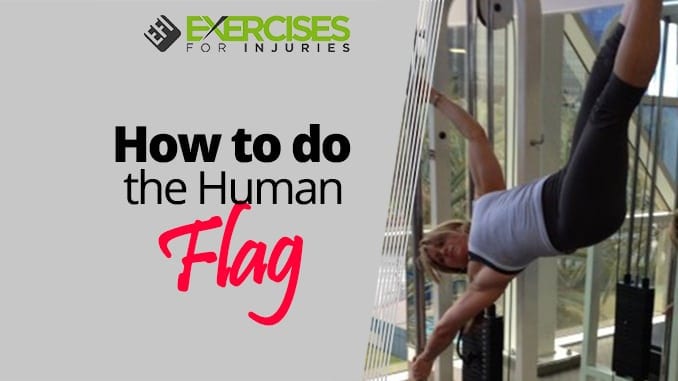
Hey, I’m Shawna Kaminski. I turned 49 on April 1st and decided it’d be cool to learn how to do the human flag. It’s a pretty impressive strength move. I was never a gymnast or anything, so I knew I had a learning curve.
You may or may not know of me. Some call me the ‘Pull Up Queen’ since I’ve mastered the pull-up. I have to say that push-ups are another strength of mine too. Mostly, I like to create challenging workouts and then try them. It’s intriguing for others; they try them, tell me about their challenge, feel another challenge come on, and the circle goes.
It’s all in the spirit of fun and motivating to push for personal bests as opposed to full-on competition, as far as I’m concerned. (But if you throw down a challenge, I’m sometimes too competitive and will take it up)
Taking On the Human Flag
So I set out to learn the human flag.
What I like about the human flag because the ‘potential’ for injury seemed minimal when I set out to learn it. The human flag (or efforts to know one) proved too much for my elbow, leading to tennis elbow pain. I suffered some pain I’d blame overuse, so I’ll give you some tips to avoid the same mistakes.
But first, I’ll give you some tips and exercises I used to help me learn the human flag.
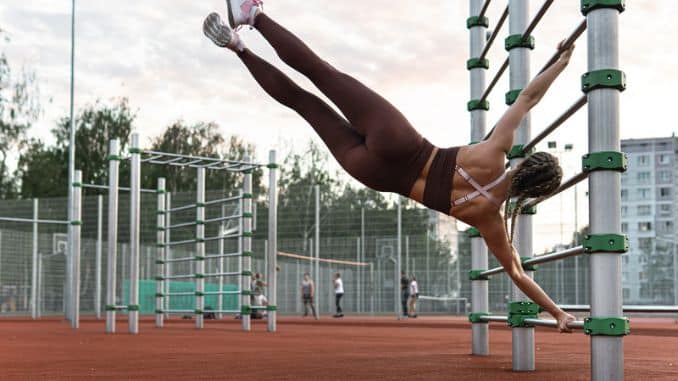
First, I had to figure out how to do a flag. There’s some technique involved that makes it a little easier; later.
Helpful Exercises for the Human Flag
Seriously, aren’t pull-ups pretty much the answer to everything? 😉 I’ll tell you that pull-ups are your ticket [1] to a thriving human flag. However, if you’re still working on getting your first pull-up, you’ll unlikely do the flag successfully. Work on the pull-up first.
This free guide will help you with that.

When doing the human flag, your core stabilizers are the foundation, so I found hanging leg raises and oblique work helpful in strengthening exercises. It would help if you had strong obliques to brace and hold the position. Here are my favorite activities for this:
1. Hanging Leg Raise
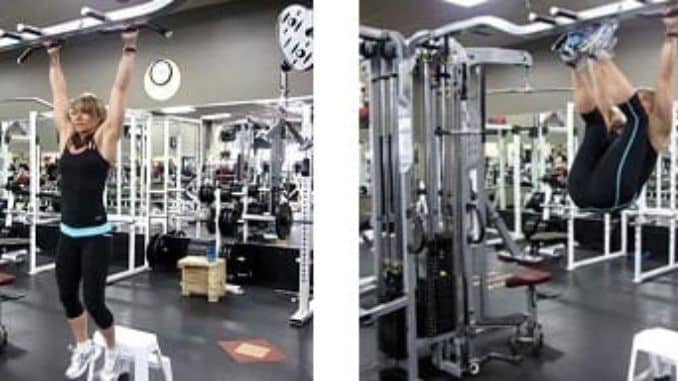
When you do hanging leg raises, be sure to rock the hips. Bring the pelvis to the ribs, and don’t just raise the knees, strengthening the hip flexors.
2. Hanging Oblique Lift
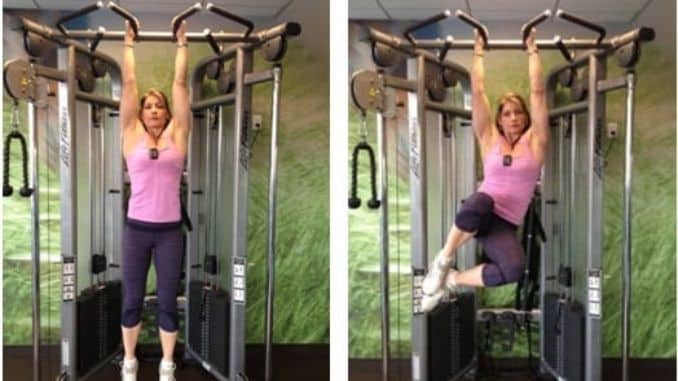
3. Barbell Windshield Wiper
4. Hanging Windshield Wiper
The hanging windshield wiper is the motherload of core/oblique work. You’ll also feel your lats while you blast the core.
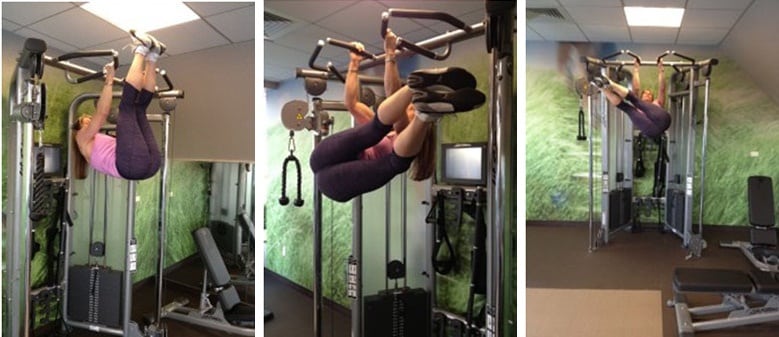 |
(Sorry for the bum shots!)
Of course, upper body strengthening [2] movements like rows and push-ups are the core of your training for the human flag.
A strong back, biceps, and triceps are necessary. The flag’s bottom arm needs tricep strength to hold the position, while the top component relies on bicep strength.
I concentrate on compound pulling and pushing exercises to strengthen the arms instead of single-joint movements. If you stick with the multi-joint activities for the upper body, you’ll have more functional strength in things like the human flag. In other words, I can’t be bothered much with doing bicep curls or tricep extensions alone, that sort of thing.
These exercises helped me succeed at learning the human flag. The flag is a challenging move; it’s so empowering once you start to do it for even a few seconds.
Learning the proper technique is helpful.
Here are a few pointers on How to do the Human Flag right
• The right pole is hard to find. Finding one with the correct diameter is rugged and easy to grip. I’m still looking for one in my gym since I live in a cold climate.
• If you live in a weather-friendly environment, traffic poles (bus stops, stop signs, no parking signs) are good.
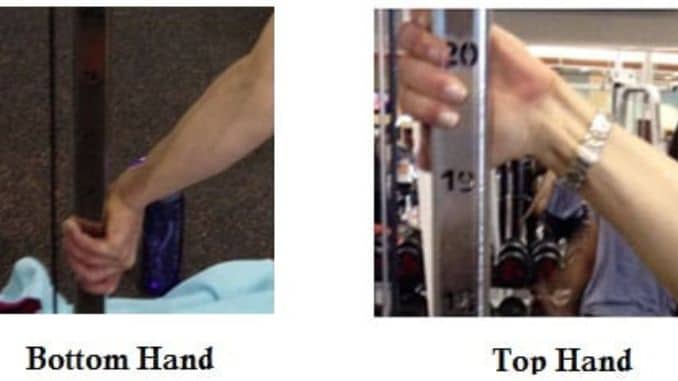
• Your grip needs to be greater than shoulder-width apart. I’ve found it easiest to lock the bottom elbow with the fingers pointing downward. The top hand also has the thumb pointing to the ground.
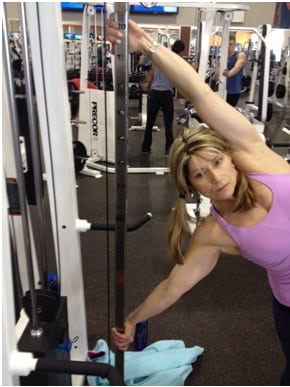
• While bracing the bottom arm, you need to stack shoulder over the shoulder, pinch the shoulder blades together and pull away from the pole with the top arm.
• Keeping the shoulders stacked on top of each other is imperative. This puts pressure on the bottom elbow since it takes all the weight.
• To avoid injury to the elbow: don’t practice too much at first. Give the elbow rest, roll the elbow with a foam roller, and don’t allow the elbow to hyperextend.
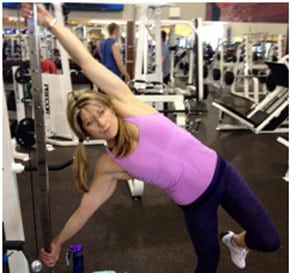
- Once the arms are in place, get ready to kick the legs up while bracing through the abs.

- Keep the legs tucked in at first by keeping the lever shorter (bent legs); it will make things easier.
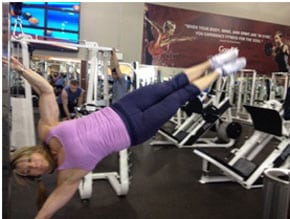
- If you can hold it any time, work on extending the legs.
- You’ll have a more robust, more thoughtful side that you’ll favor. Don’t forget to work on the weak and dumb side too.
The human flag is a worthy goal that takes time, effort, and patience. I’m getting it so I can hold it for 5 seconds or longer on a good day. It’s no Cirque de Soleil feat, but it’s progress. A significant challenge for me and anyone looking for something out of the ordinary.
If you liked this challenge, then make sure to check out my other Challenge Workouts.
In just 10 minutes or less each day, you’ll have the arms of your dreams. Say goodbye to those flabby arms forever and say hello to the sleek, sexy arms that you’ve always wanted. It’s time to start collecting those flattering sleeveless tops that you’ve always been coveting. Check out Tone and Tighten Arm Workout now!
Shawna Kaminski



